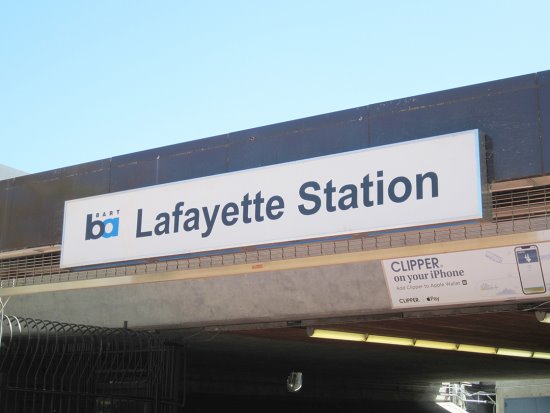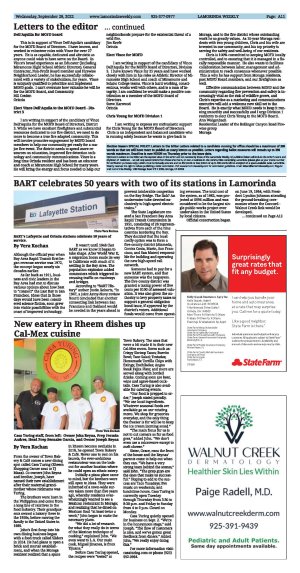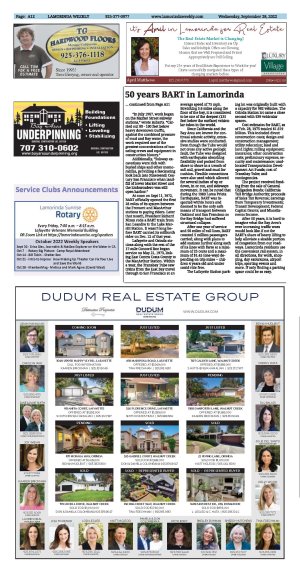| | Published September 28th, 2022
| BART celebrates 50 years with two of its stations in Lamorinda
| | | By Vera Kochan |  | | BART's Lafayette and Orinda stations celebrate 50 years of service. Photo Vera Kochan |
Although the official year when Bay Area Rapid Transit first began revenue service was 1972, the concept began nearly six decades earlier.
 As far back as 1911, business and civic leaders in the Bay Area had met to discuss various options about how best to "connect" the East Bay to San Francisco. Ideas that in those days would have been considered science fiction, soon grew into viable possibilities with the onset of improved technology.
As far back as 1911, business and civic leaders in the Bay Area had met to discuss various options about how best to "connect" the East Bay to San Francisco. Ideas that in those days would have been considered science fiction, soon grew into viable possibilities with the onset of improved technology.
 It wasn't until 1946 that BART as we know it began to take shape. After World War II, a migration boom made its way to California with much of it settling in the Bay Area. The population explosion added commuters which triggered increasing traffic on roadways and bridges.
It wasn't until 1946 that BART as we know it began to take shape. After World War II, a migration boom made its way to California with much of it settling in the Bay Area. The population explosion added commuters which triggered increasing traffic on roadways and bridges.
 According to "BART History" author Justin Roberts, "In 1947, a joint Army-Navy review Board concluded that another connecting link between San Francisco and Oakland would be needed in the years ahead to prevent intolerable congestion on the Bay Bridge. The link? An underwater tube devoted exclusively to high-speed electric trains."
According to "BART History" author Justin Roberts, "In 1947, a joint Army-Navy review Board concluded that another connecting link between San Francisco and Oakland would be needed in the years ahead to prevent intolerable congestion on the Bay Bridge. The link? An underwater tube devoted exclusively to high-speed electric trains."
 The State Legislature created a San Francisco Bay Area Rapid Transit Commission in 1951, consisting of 26 representatives from each of the nine counties bordering the Bay. They decided that the least costly option was to form a five-county district (Alameda, Contra Costa, Marin, San Francisco, and San Mateo) responsible for building and operating the new high-speed rail network.
The State Legislature created a San Francisco Bay Area Rapid Transit Commission in 1951, consisting of 26 representatives from each of the nine counties bordering the Bay. They decided that the least costly option was to form a five-county district (Alameda, Contra Costa, Marin, San Francisco, and San Mateo) responsible for building and operating the new high-speed rail network.
 Someone had to pay for a new BART system, and that someone was the taxpayers. The five-county district was granted a taxing power of five cents per $100 of assessed valuation. It was also given the authority to levy property taxes to support a general obligation bond issue, if approved by the district's voters. Additional funds would come from operating revenues. The total cost of the system, as of 1962, was projected at $996 million and was considered to be the largest single public works project ever undertaken in the United States by local citizens.
Someone had to pay for a new BART system, and that someone was the taxpayers. The five-county district was granted a taxing power of five cents per $100 of assessed valuation. It was also given the authority to levy property taxes to support a general obligation bond issue, if approved by the district's voters. Additional funds would come from operating revenues. The total cost of the system, as of 1962, was projected at $996 million and was considered to be the largest single public works project ever undertaken in the United States by local citizens.
 Official construction began on June 19, 1964, with President Lyndon Johnson attending the ground-breaking ceremonies where the Concord - Walnut Creek link would be developed.
Official construction began on June 19, 1964, with President Lyndon Johnson attending the ground-breaking ceremonies where the Concord - Walnut Creek link would be developed.
 "In July 1967, work began on the Market Street subway stations," wrote Roberts. "Carried out 80 - 100 feet below heavy downtown traffic, against the combined pressure of mud and Bay water, the work required one of the greatest concentrations of tunneling crews and equipment in construction history."
"In July 1967, work began on the Market Street subway stations," wrote Roberts. "Carried out 80 - 100 feet below heavy downtown traffic, against the combined pressure of mud and Bay water, the work required one of the greatest concentrations of tunneling crews and equipment in construction history."
 Additionally, "Subway excavations were rich with buried ships and other memorabilia, providing a fascinating look back into Nineteenth Century San Francisco when land-fill of lower Market Street and the Embarcadero was still open harbor."
Additionally, "Subway excavations were rich with buried ships and other memorabilia, providing a fascinating look back into Nineteenth Century San Francisco when land-fill of lower Market Street and the Embarcadero was still open harbor."
 At noon on Sept 11, 1972, BART officially opened the first 28 miles of its system between the Fremont and MacArthur stations to paying riders. Later that month, President Richard Nixon rode a BART train from San Leandro to the Lake Merritt Station. It wasn't long before BART carried its millionth rider on Dec. 12 of that year.
At noon on Sept 11, 1972, BART officially opened the first 28 miles of its system between the Fremont and MacArthur stations to paying riders. Later that month, President Richard Nixon rode a BART train from San Leandro to the Lake Merritt Station. It wasn't long before BART carried its millionth rider on Dec. 12 of that year.
 Lafayette and Orinda stations along with the rest of the 17-mile Concord line began service on May 21, 1973, linking East Contra Costa County to the MacArthur Station. Within a year, the Transbay Tube saw trains from the East Bay travel through to San Francisco at an average speed of 75 mph. Stretching 3.6 miles along the floor of the bay, it is considered to be one of the deepest (135 feet below the surface) vehicular tubes in the world.
Lafayette and Orinda stations along with the rest of the 17-mile Concord line began service on May 21, 1973, linking East Contra Costa County to the MacArthur Station. Within a year, the Transbay Tube saw trains from the East Bay travel through to San Francisco at an average speed of 75 mph. Stretching 3.6 miles along the floor of the bay, it is considered to be one of the deepest (135 feet below the surface) vehicular tubes in the world.
 Since California and the Bay Area are known for continual seismic activity, extensive studies were conducted. Even though the Tube would not cross any active geologic fault, the Tube was designed with earthquake absorbing flexibility and packed from shore to shore in a trench of soft soil, gravel and mud for cushion. Flexible connections were also used which allowed for several inches of up or down, in or out, and sideways movement. It can be noted that during the 1989 Loma Prieta Earthquake, BART was inspected within hours and deemed to be the only safe means of transport between Oakland and San Francisco as the Bay Bridge had suffered structural collapse.
Since California and the Bay Area are known for continual seismic activity, extensive studies were conducted. Even though the Tube would not cross any active geologic fault, the Tube was designed with earthquake absorbing flexibility and packed from shore to shore in a trench of soft soil, gravel and mud for cushion. Flexible connections were also used which allowed for several inches of up or down, in or out, and sideways movement. It can be noted that during the 1989 Loma Prieta Earthquake, BART was inspected within hours and deemed to be the only safe means of transport between Oakland and San Francisco as the Bay Bridge had suffered structural collapse.
 After one year of service and 56 miles of rail lines, BART counted 5 million passengers carried; along with plans to add stations further along each of its lines with fares at a minimum of 25 cents and a maximum of $1.45 (one-way) depending on trip miles -- children 4 years old and under could ride free.
After one year of service and 56 miles of rail lines, BART counted 5 million passengers carried; along with plans to add stations further along each of its lines with fares at a minimum of 25 cents and a maximum of $1.45 (one-way) depending on trip miles -- children 4 years old and under could ride free.
 The Lafayette Station parking lot was originally built with a capacity for 982 vehicles. The Orinda Station lot came a close second with 939 vehicular spaces.
The Lafayette Station parking lot was originally built with a capacity for 982 vehicles. The Orinda Station lot came a close second with 939 vehicular spaces.
 Cost estimates for BART, as of Feb. 28, 1975 totaled $1.619 billion. This included direct construction costs; design and construction management; utility relocation; land and land rights; rolling equipment; insurance; other construction costs; preliminary expense, security and maintenance; unallocated Transportation Development Act Funds; cost of Transbay Tube; and contingencies.
Cost estimates for BART, as of Feb. 28, 1975 totaled $1.619 billion. This included direct construction costs; design and construction management; utility relocation; land and land rights; rolling equipment; insurance; other construction costs; preliminary expense, security and maintenance; unallocated Transportation Development Act Funds; cost of Transbay Tube; and contingencies.
 The project received funding from the sale of General Obligation Bonds; California Toll Bridge Authority; proceeds of Sales Tax Revenue; earnings from Temporary Investments; Transit Development; Federal Capital Grants; and Miscellaneous Income.
The project received funding from the sale of General Obligation Bonds; California Toll Bridge Authority; proceeds of Sales Tax Revenue; earnings from Temporary Investments; Transit Development; Federal Capital Grants; and Miscellaneous Income.
 After 50 years, it is hard to imagine what the Bay Area's ever increasing traffic woes would look like if not for BART's share of heavy lifting to help alleviate a sizable portion of congestion from our roadways. Lamorinda residents use the convenient rail system, in all directions, for work, shopping, day excursions, airport trips, sporting events and more. If only finding a parking space could be as easy.
After 50 years, it is hard to imagine what the Bay Area's ever increasing traffic woes would look like if not for BART's share of heavy lifting to help alleviate a sizable portion of congestion from our roadways. Lamorinda residents use the convenient rail system, in all directions, for work, shopping, day excursions, airport trips, sporting events and more. If only finding a parking space could be as easy. |
| | | | | | | | | | | | |




